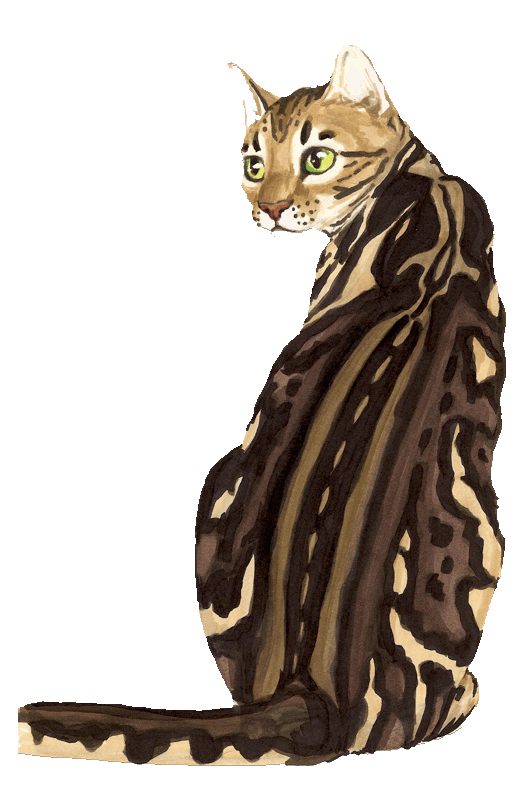

Bengals are medium to large cats, from 6-15 pounds, with males generally being larger than females.
A healthy Bengal is well muscled and has an appearance that depicts its athleticism. Bengals are
balanced cats and none of its physical features should appear exaggerated or especially pronounced.
Bengals are generally confident, curious and devoted companions. They get along well with other
pets when properly introduced and enjoy being part of a family. Each Bengal is an individual
and those interested should find out as much as they can about this wonderful breed before adding
one to their family.
HEAD:
Shape: Broad modified wedge with rounded contours. Longer than it is wide. Slightly small in proportion to body, but not to be taken to extreme. The skull behind the ears makes a gentle curve and flows into the neck. Allowance to be made for jowls in adult males. Overall look of the head should be as distinct from the domestic cat as possible.
Ears: Medium to small, relatively short, with wide base and rounded tops. Set as much on side as top of head, following the contour of the face in the frontal view, and pointing forward in the profile view. Light horizontal furnishings acceptable; but lynx tipping undesirable.
Eyes: Oval, almost round. Large, but not bugged. Set wide apart, back into face, and on slight bias toward base of ear. Eye color independent of coat color except in the lynx points. The more richness and depth of color the better.
Chin: Strong chin, aligns with tip of nose in profile.
Muzzle: Full and broad, with large, prominent whisker pads and high, pronounced cheekbones. Slight muzzle break at the whisker pads.
Nose: Large and wide; slightly puffed nose leather.
Profile: Curve of the forehead should flow into the bridge of the nose with no break. Bridge of nose extends above the eyes; the line of the bridge extends to the nose tip, making a very slight, to nearly straight, concave curve.
Neck: Long, substantial, muscular; in proportion to the head and body.
BODY:
Torso: Long and substantial, not oriental or foreign. Medium to large (but not quite as large as the largest domestic breed).
Legs: Medium length, slightly longer in the back than in the front.
Feet: Large, round, with prominent knuckles.
Tail: Medium length, thick, tapered at end with rounded tip.
Boning: Sturdy, firm; never delicate.
Musculature: Very muscular, especially in the males, one of the most distinguishing features.
COAT,COLOR,PATTERN:
Length: Short to medium. Allowance for slightly longer coat in kittens.
Texture: Dense and luxurious, closelying, unusually soft and silky to the touch.
Patterns: Spotted or marbled.
Spotted: Spots shall be random, or aligned horizontally. Rosettes showing two distinct colors or shades, such as paw print shaped, arrowhead shaped, doughnut or half-doughnut shaped or clustered are preferred to single spotting but not required. Contrast with ground color must be extreme, giving distinct pattern and sharp edges. Strong, bold chin strap and mascara markings desirable. Virtually white undersides and belly desirable. Blotchy horizontal shoulder streaks, spotted legs and spotted or rosetted tail are desirable. Belly must be spotted.
Colors:
Brown Tabby: All variations of brown are allowed. Markings various shades of brown to black. Light spectacles encircling the eyes and a virtually white ground color on the whisker pads, chin, chest, belly and inner legs is desirable.
Seal Sepia Tabby, Seal Mink Tabby, and Seal Lynx Point Tabby: Pattern can be various shades of brown. There should be very little or no difference between the color of the body (pattern) markings and point color. (external link: http://www.tica.org/public/breeds/bg/intro.php)



